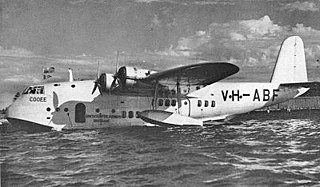
The Letov Š-18 was a Czechoslovak single-engined, two-seat biplane trainer. It was designed by Alois Smolík at Letov Kbely. The Š-18 first flew in 1925.

The Albatros L 75 Ass was a German trainer biplane of the 1920s. Of conventional configuration, it seated the pilot and instructor in separate, open cockpits. The wings were single-bay, equal-span, and had a slight stagger. Production continued after Albatros was absorbed by Focke-Wulf.

The Arado S I was a biplane trainer built in Germany in 1925. The first of three prototypes was powered by a Bristol Lucifer radial engine, while the other two Arado S.Ia aircraft were fitted with the Siemens-Halske Sh 12. The Siemens-Halske Sh 11 powered the Arado S III, a virtually identical aircraft of which only a single prototype was constructed and sold to Turkey.
The Arado W 2 was a two-seat twin-engine seaplane trainer developed for the DVS in 1928. It was a cantilever monoplane with a fabric-covered steel tube fuselage that accommodated the pilot and instructor in tandem open cockpits. The undercarriage consisted of two pontoons carried on steel struts.

The Avia BH-29 was a trainer aircraft built in Czechoslovakia in 1927, in the hope of marketing it to both the Czechoslovakian Army, and to Czechoslovakian Airlines as a primary trainer. It was a conventional design, an unequal-span biplane of wooden construction and with tailskid undercarriage. The pilot and instructor sat in tandem open cockpits. A more powerful version was built, powered by a 120 hp (89 kW) Walter NZ-120 radial engine.

The Breda A.4 was a biplane trainer produced in Italy in the mid-1920s. It was of conventional configuration with a two-bay unstaggered wing cellule and seating for the pilot and instructor in tandem open cockpits. Apart from civil use, the A.4 was also adopted by the Regia Aeronautica as a trainer. At least some examples were produced in floatplane configuration as the A.4idro.

The Breda A.9 was a biplane trainer produced in Italy in 1928 for the Regia Aeronautica. Conventional in design, it featured a single-bay, unstaggered wing cellule and fixed tailskid undercarriage. The student and instructor sat in tandem, open cockpits. A slightly smaller version, designated A.9-bis was developed for use in Italy's aeroclubs.
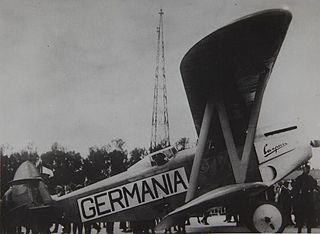
The Caspar C 32 was an aircraft developed in Germany for aerial spraying in the late 1920s. It was a single-bay biplane with staggered, equal-span wings that accommodated the pilot and a single passenger or observer in tandem open cockpits. A small, additional horizontal stabiliser was fitted near the top of the tall single tail fin above the main horizontal stabiliser.
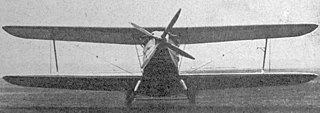
The Caspar C 35 Priwall was a German airliner of the late 1920s, of which only a single example was built. It was a large, single-engine, single-bay biplane of conventional configuration with fixed tailskid undercarriage. The staggered, equal-span wings were braced with a large I-strut. Not only were the passengers seated within a fully enclosed cabin, but the flight deck was fully enclosed as well.

The Focke-Wulf A 20 Habicht was an airliner developed in Germany in the late 1920s. It was a high-wing cantilever monoplane with fixed tailskid undercarriage. The fuselage was deep and seated four passengers in a fully enclosed cabin. The type was not bought by the airlines and only a few examples were built.

The Focke-Wulf S 2 was a trainer aircraft built in Germany in the late 1920s. It was a conventional parasol-wing monoplane with fixed tailskid undercarriage. The pilot and instructor sat side by side in an open cockpit. Only a single example was built.
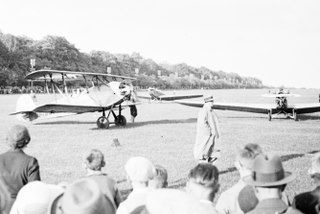
The Focke-Wulf S 24 Kiebitz was a sport aircraft built in Germany in the later 1920s. It was a single-bay biplane of conventional design with equal-span, unstaggered wings, braced with N-type interplane struts. The pilot and a single passenger sat in tandem open cockpits, and it was fitted with a fixed tailskid undercarriage. The wings could be folded for transportation or storage, and the aircraft was designed to be towed by a car.

The Heinkel HD 22 was a trainer designed in Germany during the 1920s. It was a conventional single-bay biplane with staggered wings braced with N-type interplane struts. The pilot and instructor sat in tandem, open cockpits, and the main units of the fixed, tailskid undercarriage were linked by a cross-axle.

Rohrbach Ro V was a seaplane manufactured by the Rohrbach Metall-Flugzeugbau company in Berlin, Germany. Only one was built, in 1927. It was delivered to Severa GmbH for comparison flights with the Dornier Do J "Superwal" and as a seaplane trainer. It was used for commercial flights in 1928 by the Deutsche Luft Hansa for the Travemünde to Oslo route.
The Renard R.17 was a Belgian four-seat cabin monoplane designed and built by Constructions Aéronautiques G. Renard. The high cantilever wing was an unusual feature when most contemporary aircraft still had braced wings. Designed as a high-speed transport for fresh flowers, no aircraft were ordered and the only R.17 was retained by the company until 1946.

The IMAM Ro.5 was a sport aircraft produced in Italy in the late 1920s. It was a conventional, parasol wing monoplane with fixed tailskid undercarriage and two open cockpits in tandem. It proved popular with private owners and flying clubs, and was built in large numbers. Some Ro.5s were purchased by the Regia Aeronautica for use as trainers and liaison aircraft. A later version, the Ro.5bis, enclosed the cockpits under a long canopy.

The SABCA S.2 was an airliner built in Belgium in 1926. It was a conventional, high-wing cantilever monoplane with fixed, tailskid undercarriage. The flight deck was open, but the passenger cabin was fully enclosed. Power was provided by a single engine in the nose, driving a two-blade propeller, and whose exhaust was collected in a single stack that extended up over the wing. Metal was construction throughout, with corrugated skin. Only a single example was built, which served with SABENA.

The Canadian Vickers Vista was a Canadian-designed single-seat flying boat.

The Federal Aircraft CM-3 was an aircraft built by mechanics from the Ryan Company.
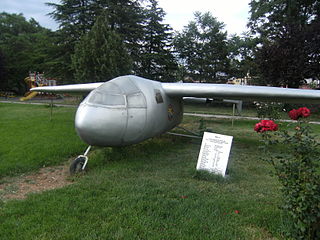
The THK 11 was a 1940s prototype Turkish four-seat monoplane, designed and built by Türk Hava Kurumu.

